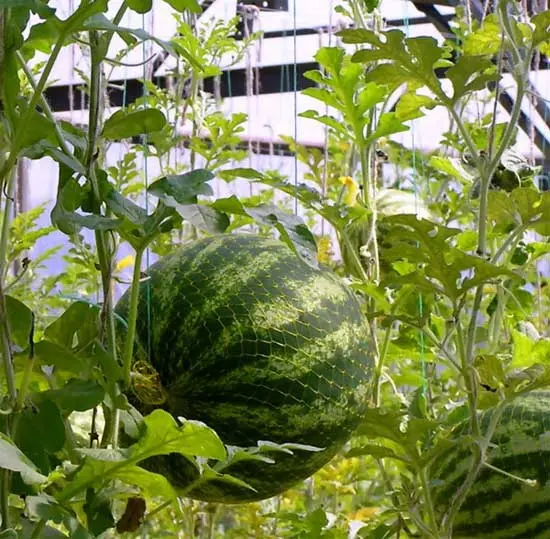Contents
A modern summer resident of the Moscow region grows many different crops, including watermelons in a greenhouse. The agrotechnics of melons is somewhat different from the process of working with greenhouse crops, so we will tell in the article about how to grow a juicy watermelon in a greenhouse, and organize the whole process as correctly as possible. Modern methods of agricultural technology, selected varieties of seeds and at least a little knowledge of care will allow you to grow delicious juicy watermelons in your own summer cottage, whether in the Moscow region or the lands of Siberia.
Basic Growing Requirements
All representatives of gourds are plants for which a long daylight and warmth is extremely important. Therefore, in order for the harvest to be good, it is necessary to provide in the greenhouse the most identical natural conditions for the vegetation of the crop. For the full life of a watermelon in a greenhouse, the temperature should be at least + 30 degrees Celsius during the daytime, and at night it should not fall below + 18 degrees Celsius.
To create such a temperature and light regime for growing watermelons in a greenhouse, it is necessary to use special heating and ventilation systems, as well as careful care. Melon berries normally adapt to drought, but waterlogging can be detrimental to the vegetation of the crop. The optimum humidity for watermelons should always be kept within 60%.
Gourds, including watermelon, are very susceptible to the characteristics of the soil and climate in general. Therefore, for planting in Siberia and in the Moscow region, completely different varieties of seeds will be required.
Choosing a grade
When choosing seeds for sowing in the Moscow region or another region, you are guided by a local producer. You should not choose varieties with large fruits, since the cultivation of watermelon in a greenhouse requires uniform compliance with growing conditions throughout the entire growing season. Small fruits reach ripeness much faster. By the way, varieties with small fruits are capable of producing much more ovaries after planting than large-sized ones.
If we talk about the “maturity” of seeds, then it is better to choose fresh seed, as they germinate in Siberia and the Moscow region much more actively than their mature counterparts. If you are new to growing such a berry, then for the first experience, try planting the Ogonyok variety. The seeds are easily taken and produce early ripening small fruits. Ripe watermelon reaches from 1 to 2 kg, the pulp is juicy and sugary, the outer color of the peel is green-black.
For growing greenhouse watermelons in Siberia and in the central regions of Our Country, varieties such as Sibiryak, Gift to the North, Siberian Lights are suitable, as they are early ripening and cold-resistant. For the Moscow region, the best option would be Cinderella, Ultra Early, Pink Champagne.
Video “Watermelons in a polycarbonate greenhouse”
Seed and seedling preparation
The start of work in the greenhouse falls on mid-April. Before planting, seeds must be sorted in brine. To do this, dissolve 1 tsp in one glass of water. salt and throw seeds – floating seeds are not suitable for planting. Then the selected seeds are thoroughly washed in fresh water, and then placed in a solution of 1% potassium permanganate for half an hour. After the seeds should be washed well.
To increase germination, the seed is soaked in warm water or in an immunostimulant solution. After a few days, the seeds hatch and at this time they are planted in pots with soil for seedlings. The soil mixture is pre-prepared. Below is the calculation of the components for one bucket of soil mixture:
- soil – ¼ bucket
- humus – ¾ buckets
- fertilizers (potassium, nitrogen) – 1 tbsp.
- phosphorus mixture -3 tbsp.
- potassium sulfate – 1 tsp.
A glass of wood ash would be useful. Seeds should be planted in the ground by 2-3 cm, and the seed should be placed sideways. Choose pots for seedlings with a diameter of at least 10 cm. The temperature in the greenhouse where seedlings are grown should be within 22-25 degrees Celsius, and after the first shoots appear, the degree is reduced to 21-23. Pots with seedlings until the emergence of seedlings are closed with a film. At this stage, it is important to provide a long daylight hours (12-14 hours) with artificial lighting.

Place pots with seedlings so that the leaves of the “neighbors” do not touch each other. After ten days, the seedlings must be fed with mineral fertilizers, it is not recommended to do it earlier. Two weeks later, the second dressing. You can plant seedlings in a greenhouse after a month, when the seedlings will have from three to five true leaves.
We prepare a place for landing
Transplanting seedlings into a greenhouse requires careful preparation, and this process should begin in the first months of spring. A polycarbonate greenhouse is great for growing gourds, but it is important to respect the dimensions, namely the height should be 170-200 cm. Planting seedlings in greenhouse soil is possible in mid-May, when the daytime temperature is set at around 20-25 degrees, and at night – at least 5. Be sure to prepare a film or thick paper in case of sudden frosts.
We prepare the soil for transplanting in advance. 7 days before transplanting, a layer of soil is removed to the depth of a shovel and hay with humus is laid. Nitrogen fertilizers are poured from above, after which everything is poured with hot water. After a “hot shower”, the soil is returned back, creating a layer of 2-3 cm, and the area is covered with black film or paper. So you can warm up and fertilize the soil well before planting.

In mid-May, when the seedlings have real leaves, they are transplanted into a greenhouse. The entire plot is divided into beds with a width of at least 1 meter. It is necessary to plant to a depth of 10 cm, observing the distance between adjacent crops of 50-100 cm. In order for the seedlings to acclimatize faster, cover it with a film. Over the next ten days, the seedlings “get used” to the new conditions, so your task is only to maintain the desired temperature and periodically ventilate.
Care for watermelon
Caring for watermelon crops in the Moscow region requires patience and time. The first thing to ensure is watering in a polycarbonate greenhouse until flowering with warm water in the evening (three times within 7 days). With flowering, watering is reduced. Try to avoid getting water on the leaves, as well as the formation of condensation in the greenhouse.

The second condition for care is fertilizing with nitrogen fertilizers and chicken manure:
- the first – when the lashes reach 25-50 cm;
- the second – before the formation of buds;
- the third – after the formation of the ovary.
Pollination of culture can be artificial (manual) or natural. By planting honey plants near watermelons, you will ensure that bees are available for pollination. On the tenth day after transplantation, a garter is tied to the trellis. Following our recommendations, you can easily provide the necessary care and grow watermelons in a greenhouse in a summer cottage, both in the Moscow region and in Siberia.
Video “Greenhouse for growing watermelons”
If you want to learn more about the process of growing watermelons in greenhouses, then this video is what you were looking for.









